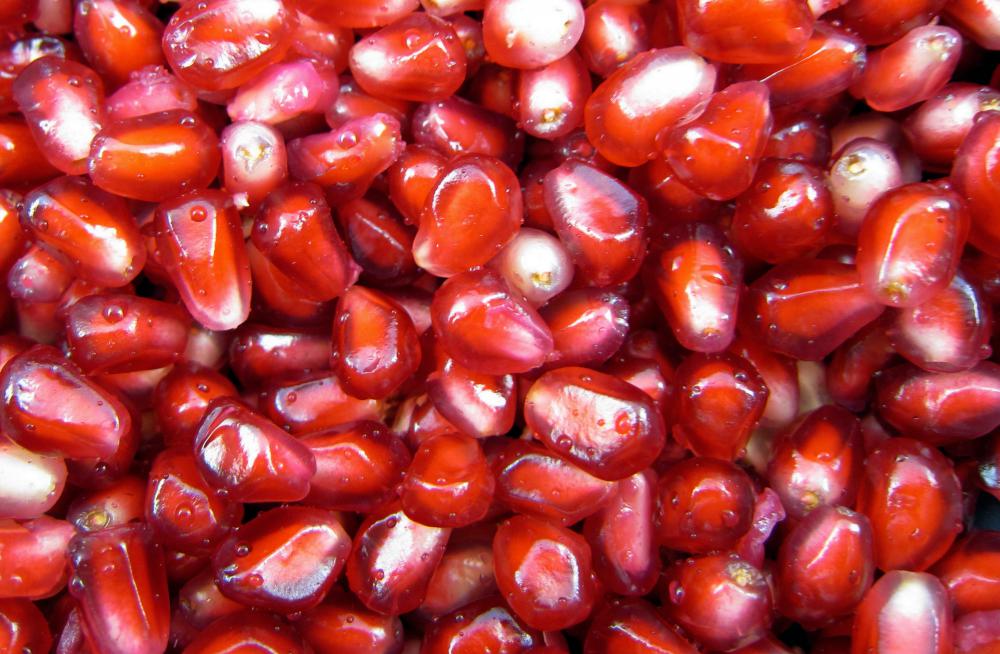At DelightedCooking, we're committed to delivering accurate, trustworthy information. Our expert-authored content is rigorously fact-checked and sourced from credible authorities. Discover how we uphold the highest standards in providing you with reliable knowledge.
How Do I Choose the Best Pomegranate?
Pomegranates are popular fruits that have a tough, leathery skin on the outside and hundreds of edible seeds on the inside. A pomegranate should be tart-sweet and juicy and is thought to be full of health benefits. The fruit can be bought in juice or frozen form but is also popularly eaten in its natural state. Choose the best ripe pomegranate based on season, color, and skin quality as well as size, shape, and weight.
If pomegranates are grown in the area you live, then choose to eat them when they are in season. In areas where the fruit is not naturally grown, it must be transported, and thus, the season for availability is usually later. In the Northern Hemisphere, for example, pomegranates are considered in season from around October through December. If you buy the fruit outside of these months, they may be under or overripe.

It is best to choose a pomegranate that has a deep, rich color. Deep red ones are usually recommended, but colors can vary from yellow-orange to purple-red. You want to choose the ripest one available as the fruits are picked before they are quite ripe if they need to be transported and will not get riper once they have been picked.
The skin of the pomegranate should be firm and tight. Rub your finger over the skin; it should not move or wrinkle. Although the skin can have superficial scratches and marks, it should not be broken in any way because this both lets out the juice and creates an entrance for bacteria. Cracks can also indicate overripeness. You should choose a fruit with skin that is leathery and looks like it is just beginning to lose its shine.
If the skin is dull with no shine, then the fruit may be overripe, and if the skin is very shiny, the fruit may not be ripe enough. The skin should also feel supple. If the skin is dry, then the fruit inside is likely dry as well. Try also to choose a fruit with a skin that is tough but not too thick — this can make the pomegranate more difficult to peel. The pomegranate should not have a strong smell or be wet or sticky.
Choose a pomegranate that is large as these tend to have juicier seeds. You also want it to be plump, round, and firm. Do not choose a fruit with any flat or soft spots — this can indicate a bruised, crushed, or dried-out area. You can squeeze the top of the fruit to help determine ripeness. If it is very hard, then the fruit is not ripe, too soft and it is too ripe, and if it releases a dusty puff, it may be moldy. Finally, choose a pomegranate that feels heavy for its size, which indicates a very juicy fruit.
AS FEATURED ON:
AS FEATURED ON:











Discussion Comments
@Terrificli -- Regionalism does come into play when it comes to the availability of fresh fruit. Still, things have improved a lot over the years and the pomegranate is now so popular that it is easier to find than ever.
Of course, a lot of pomegranates being available does not necessarily mean a lot of good pomegranates will be available. That being the case, the information in this article is solid.
Depending on what part of the world you happen to be standing in, finding pomegranate fruit at all may be a challenge. Forget about finding the ripest of the bunch, you might just be lucky to see one or two at your local grocery store.
But, isn't that always the case? Your selection of fresh fruit is often limited to how regional the fruit is. Pomegranates are no exception to that rule.
If you do have problem getting good pomegranates where you live, you might consider pomegranate juice as an alternative. That stuff is easier to transport and stays "good" longer than the fruit itself does.
Post your comments